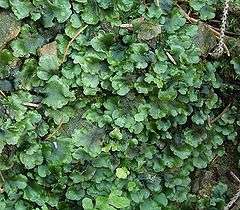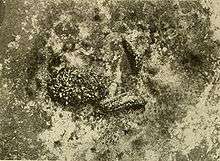Kerry slug
| Kerry slug | |
|---|---|
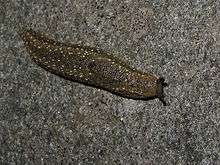 | |
| Photo of dorsal view. | |
 | |
| Drawing of right side view. | |
| Scientific classification | |
| Kingdom: | Animalia |
| Phylum: | Mollusca |
| Class: | Gastropoda |
| (unranked): | clade Heterobranchia clade Euthyneura |
| Superfamily: | Arionoidea |
| Family: | Arionidae |
| Genus: | Geomalacus |
| Subgenus: | Geomalacus |
| Species: | G. maculosus |
| Binomial name | |
| Geomalacus maculosus Allman, 1843[2] | |
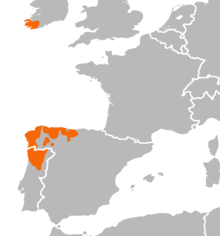 | |
| Synonyms[3] | |
|
Geomalacus grandis Simroth, 1894[4] | |
The Kerry slug or Kerry spotted slug, scientific name Geomalacus maculosus, is a rare species of medium-sized to large air-breathing land slug. It is a terrestrial pulmonate gastropod mollusc in the family Arionidae, the roundback slugs.
An adult Kerry slug generally measures 7–8 cm (2.8–3.2 in) in length and is dark grey or brownish in colour, with yellowish spots. The internal anatomy of the slug shows some unusual features, and some characteristic differences from the genus Arion, which is the type genus of the family Arionidae. The Kerry slug was described in 1843, rather late compared to many other relatively large land gastropods that form a part of the fauna of the British Isles; this is one indication of this slug's rarity and its secretive habits.
Although the distribution of this slug species does include some wild habitats in southwestern Ireland (e.g. in County Kerry), the species is more widespread in north-west Spain and from central to northern Portugal. However, it is not found anywhere between Ireland and Spain. The species appears to require environments that have high humidity and acidic soil (soil with no calcium carbonate in it). The slug is mostly nocturnal or crepuscular, although in Ireland it is active on overcast days. It feeds on lichens, liverworts, mosses and fungi, which grow either on boulders or on tree trunks.
This rare species is officially protected by conservation laws in each of the three countries in which it occurs. However, the survival of the Kerry slug is nonetheless threatened because it lives only in completely wild, unspoiled habitat of a particular type: acidic woodlands and moorlands that support the species of lower plants on which the slug relies for food. This habitat type is itself at risk from a number of different factors, ranging from climate change to the construction of roads. Attempts have been made to establish breeding populations in captivity, to help ensure the survival of this slug species, but with only limited success.
Taxonomy
The Kerry slug is a gastropod, as are all other snails and slugs, including slugs and snails that live in saltwater, those that live in freshwater, and those that live on the land. This is a land slug which breathes air, a pulmonate. It is in the clade Stylommatophora, which means that its primitive eyes or eye spots are carried on the tips of its two upper tentacles. Despite superficial similarities, not all land slugs are in the same family or superfamily. The Kerry slug is an arionid, or round-backed slug; it has no keel on its back, in contrast to the land slugs in the family Limacidae and Agriolimacidae. It also shares numerous internal anatomical features with slug species in other genera within the family Arionidae, including the Arion slugs, which are most typical of the family.
The Kerry slug's scientific name or binomial name is Geomalacus maculosus. It is in the genus Geomalacus, a name which literally means "earth mollusc". Its specific name maculosus means "spotted", from the Latin word macula "spot".[6] The English language vernacular name (or common name) is derived from the name of County Kerry, which is the county in the southwest of Ireland where this species was first collected, and which is also the type locality, as mentioned in the original description.
The scientific name of the species is also sometimes written as Geomalacus (Geomalacus) maculosus. This is because the genus Geomalacus contains two subgenera: the nominate subgenus (subgenus of the same name) Geomalacus and a second subgenus Arrudia Pollonera, 1890. The subgenus Geomalacus contains only one species, the Kerry slug. The subgenus Arrudia includes three species.
This slug species was originally described and named from specimens collected in Ireland. In 1842, an Irish naturalist named William Andrews (1802–1880) sent material that he had found at Caragh Lake in County Kerry to the Irish naturalist George James Allman,[2] who then introduced the slug to science as a new species.
The Kerry slug has been included in molecular phylogenetic studies since 2001.[7]
Description
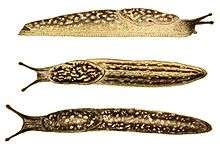
The body length of adult slugs of this species is 7–8 cm (2.8–3.2 in).[8] However it is difficult to measure these slugs accurately because of their unusual startle response (see the section entitled behaviour). Kerry slugs can also elongate themselves within crevices up to 12 cm (4.8 in).[8] "Official" measurements of this species vary; for example, Kerney et al. (1983)[9] give a range of measurements for the species: 6–9 cm (2.4–3.6 in). The body of a fixed (preserved) adult specimen was 7 cm (2.8 in) long with a mantle length of 3 cm (1.2 in).[8]

The body of these slugs is glossy, and is covered on the left and right sides with about 25 longitudinal rows of polygonal granulations (very small knobs with outlines like polygons).
The slugs have two colour morphs depending on the type of habitat where they are found, suggesting that they are using camouflage.[10] There can also be variation in relation to banding. On each side of the body there can be two bands: one band just below the summit of the back, and the other band further down the side of the body. When these bands are present they usually extend the whole length of the body of the slug, and are overspread by numerous, somewhat oval, yellowish spots. These yellow spots are distributed more or less in five longitudinal zones.[11]

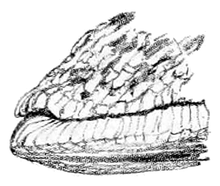
Behind the animal's head, the "shield" (the shield-shaped outer surface of the mantle) is about a third of the length of the body when the slug is actively crawling and thus extended, but only about half of that when the slug is motionless and contracted. The shield is rounded in front, and bluntly pointed behind. The texture of the surface of this area resembles the underside of undyed leather. It is spotted with pale buff or whitish spots which are similar to those on the body, but more uniformly distributed.[11]
The foot-fringe (a band of tissue around the edge of the foot) is not very distinctly separated: it is very pale and somewhat expanded, with indistinct lines on it.[11] The sole (the underside) of the foot is a pale grayish-yellow in colour, and is divided into three indistinct bands, with the mid-area being somewhat darker and more transparent than the side bands.[11] There is a caudal mucous pit situated between the foot and the body on the upper surface of the tip of the tail. The pit (which collects extra mucus) is not very conspicuous, but it is triangular in shape and opens transversely (i.e. from side to side). The mucous pit often carries a transparent yellowish ball of slime (mucus).[11]
The upper tentacles are smoky-black or grey, short and thick, with oval ends, and have the usual eye spots at their tips. The genital pore (or opening) lies behind and below the right eye-tentacle.[12] The lower tentacles are pale translucent grey.[11] The skin mucus is usually pale yellow, and varies in its degree of viscosity (stickiness). The locomotory-mucus (mucus for crawling on) is tenacious and usually colourless, but it can be yellowish because of having mixed with the body slime.[11]
Internal anatomy
Shell
Most land slugs have, within the mantle, the remnants or residue of what was, in the evolutionary past, a larger external shell. In most slugs, this remnant takes the form either of a small internal shell (a thin shelly plate), or a collection of calcareous (chalky) granules. In this species there is an internal shell or shell plate which resembles that found in land slugs of the genus Limax. In other words, the shell plate in this species is oval in shape, solid, and chalky, with a transparent conchiolin (horny) base. The shell plate is usually somewhat convex above and concave beneath, with a few indistinct concentric lines of growth, and is covered outwardly with a very thin transparent periostracum (a protein layer), and with the nucleus (the oldest growth part) situated near the front. In young Kerry slugs the shell is very thin and convex, abruptly cut off behind, and with an extremely thin layer that projects in front and contains minute granules.[11]
The shell plate has been drawn differently by authors, but do at least show that it is a solid plate:
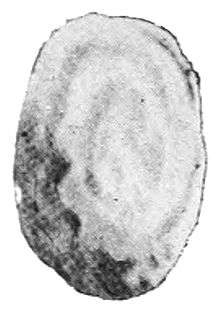 The internal shell as drawn by Taylor in 1907 |
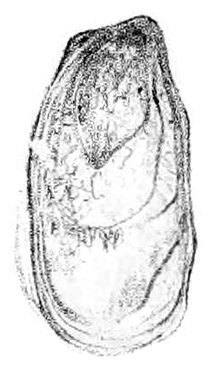 The internal shell as drawn by Godwin-Austen in 1882 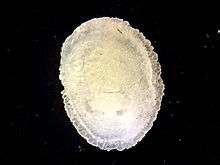 Photograph of internal shell of G. maculosus (dorsal view). |
Various organ systems
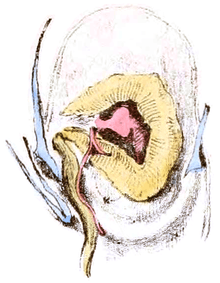
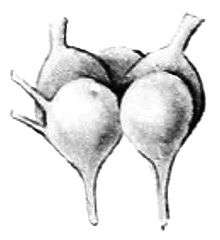
The circulatory and excretory system are closely related, in that the heart is surrounded by the triangular kidney. The kidney has a lamellate (layered) structure and it has two ureters. In this slug species, the ventricle of the heart is directed towards, and is very close to, the anal and respiratory openings. The ventricle of the heart is further away and further back than it is in species of the related genus Arion, the type genus of the family Arionidae.[11]
The gland above the foot, the suprapedal gland, is deeply imbedded in the tissues, and reaches far back. The cephalic (head) gland known as the Semper's organ is well developed, and shows as a pair of strong flattened lobes. The salivary and digestive glands are the same as those found in Arion species, but the vestigial osphradium (kidney-like structure) within the mantle chamber is more distinct than it is in Arion species.[11]
Muscles
As for the various muscles within the slug, the cephalic retractors (muscles for pulling in the head) are very much the same as they are in Arion species. The right and left tentacular muscles, which pull in all four of the tentacles, divide early for the upper and lower tentacles, but only the muscles of the ommatophores (the muscles of the two upper tentacles, which have eye spots) are darkly pigmented. The right and left muscles that pull in the eyespot tentacles are attached at the base to the back edge of the mantle, on the right and left respectively. The pharyngeal (throat) retractor muscle is, as usual, furcate (split) for attachment to the back of the buccal bulb (mouth bulb), and the root of this muscle is fixed on the right side of the body, just behind where the right tentacular muscle is attached.[11]
Reproductive system
Kerry slug is hermaphrodite as all other pulmonates. Its reproductive system is diagnostic feature.[13] The genus Geomalacus has a special feature: the atrium has a diverticulum. This atrial diverticulum is an elongated part of the atrium.[13] The penis in the genus Geomalacus is reduced and lost as well its penial retractor muscle. The atrial diverticulum is a secondary penial structure and with its spermatheca retractor muscle acts as a copulatory organ instead.[14] The other end of the spermatheca retractor muscle extends to the posterior end of the body.[13] The atrial diverticulum has been proposed to be the morphological equivalent (analogy, homoplasy) of a penis.[14]
Geomalacus maculosus has an atrial diverticulum longer than the spermatheca duct,[13] while Geomalacus anguiformis has an atrial diverticulum shorter than the spermatheca duct.[13]
Various authors have depicted the reproductive system of Kerry slug: Godwin-Austen (1882),[15] Sharff (1891),[12] Simroth (1891, 1894),[4][16] Taylor (1907),[11] Germain (1930),[17] Quick (1960)[18] and Platts & Speight (1988).[13] Platts & Speight (1988)[13] consider from previous authors depiction by Godwin-Austen (1882)[15] to be the most accurate, because other authors depicted atrium too short.
The Kerry slug's reproductive organs are as follows: there is a small, compact, and darkly pigmented ovotestis (a combination of ovary and testis). There is a hermaphroditic duct (male and female duct) which is very long and greatly convoluted, and ends in a small spherical vesicula seminalis (seminal vesicle). The albumen gland (which creates albumen for the eggs) is elongated and shaped like a tongue. The ovispermatoduct (a duct that carries both eggs and sperm) is very much twisted. The free oviduct (duct that carries eggs only) is rather long and thin, but without any enlargement.[11]
The vas deferens (carries sperm) is very long, complexly twisted, and rolled up in the form of a bundle. The spermatheca (for storing sperm) is globular, with a short stem, but is quite distant from the genital pore (where the whole elaborate system opens to the outside world). The spermatheca is distant from this opening because of the remarkable elongation of the atrium or vestibule (a common area which is usually just inside the genital pore, the atrium is an area where both the male and the female systems open). There is a long retractor muscle from the vesicle, and its stem is fixed internally to the back of the slug in the median line (midline of the body) near the caudal end (tail end) of the body. The vas deferens and the spermatheca open nearly together into the far extremity of the atrium, which is prolonged in an attenuate form (drawn out in length) to an enormous extent. The very thin free oviduct (egg-carrying duct) opens into the atrium much nearer the near end, where the muscular vestibule is greatly but irregularly enlarged, and connected to the oviduct by a number of muscular fibres.[11]
Within the vagina (the female organ which receives the copulatory organ during copulation) there is a curious series of flattened folds, the central part has a pointed end which is situated close to the genital pore, and this pointed end may possibly be a sarcobelum (a very much reduced version of an organ that makes love darts) and thus may be the homologue (a similar structure because of shared ancestry) of the love dart in the Helicidae.[11]
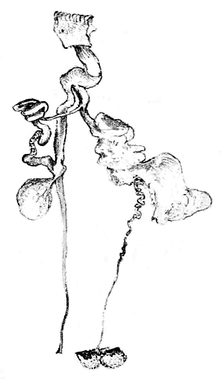 The reproductive system by Godwin-Austen (1882).[15] The large mass on the right is albumen gland, the mass on the lower part right is the ovotestis, the oval shape at the left is the spermatheca. Mantle edge and atrium is at the top. |
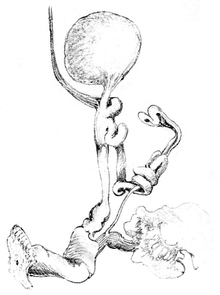 Drawing of "male part" of the reproductive system. From lower left to upper left: genital pore, atrium, atrial diverticulum, spermatheca duct, spermatheca retractor muscle, spermatheca. On the top right: epiphallus. Center: vas deferens. Lower right: free oviduct, spermoviduct. |
Apparatus for feeding
Radula
The radula is a feeding structure found only in molluscs. Typically it is a small but strong ribbon-like structure with numerous complex rows of tiny teeth across it. The radula is situated inside the mouth.
In this species of slug, the radula is 8 mm (5/16 in) long and 2 mm (1/16 in) wide, and has 240 slightly curved transverse (crosswise) rows of denticles (tiny teeth). Each row of teeth is composed of one median tooth and 10 lateral and marginal teeth on each side. The median teeth are small, and are clearly unicuspid (having one cusp), though they are slightly shouldered. The lateral teeth are bicuspid (having two cusps) but the admedian (next to the middle) teeth are noticeably larger than the median row, and the mesocone (an extra protrusion in the middle of the tooth) is well developed. There is however, no distinction between the lateral and marginal series except that the ectocone (extra little side protrusion) present on the admedian teeth recedes in position and slightly diminishes in size in the succeeding teeth up to about the twentieth row on the radula, but in the marginal series, the ectocone gradually grows in size and importance as the margin is approached, while the mesocone becomes almost correspondingly diminished, the outermost teeth showing a more embryonic (more like that of an embryo) character.[11]

Jaw
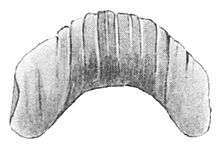
The jaw measures about 1 mm (1/32 in) from side to side, and is distinctly arcuate (arched) from front to rear, lunate (crescent-moon shaped) in shape, but very wide, with broad and slightly rounded ends. The jaw is solid, dark-brown and has about 10 broad flat ribs only in the middle part of the jaw. These ribs are absent or scarcely discernible on the side areas. Where the ribs meet the upper edge they sometimes form crenulations ( a scalloped effect) and may also produce the same effect on the lower edge of the jaw. In other individuals the ribs extend all the way across the jaw, making both the upper and the cutting edges of the jaw clearly denticulate (noticeably toothed in outline).[11]
The alimentary canal of the digestive system forms two loops, as is true of all species within the family Arionidae.[19]
Distribution

Geomalacus maculosus has what is known as a disjunct distribution (in other words, it occurs in discontinuous locations). This slug is found only in southwestern Ireland, north-west Spain, and from central Portugal to northern Portugal.[20] The presence of this slug in southwest Ireland might seem anomalous, but similar distribution patterns have been observed in a few other species of animals and plants. This particular disjunct distribution (in Iberia and in Ireland without any intermediate localities) is known as "Lusitanian".
There has been speculation that the G. maculosus was introduced to Ireland from Iberia by prehistoric humans, as appears to have happened in the case of the Eurasian pygmy shrew.[21][22] In support of this, the genetic diversity of the slug in Ireland was found to be greatly reduced compared with the Iberian populations.[23][24]
Ireland
Within Ireland, this species of slug is known from areas with sandstone geology in West Cork and County Kerry,[25] a total area of around 5,800 km2 (2,200 sq mi).[8] In 2010, a previously unknown population of the Kerry Slug was recorded in a third county, Co. Galway.[26]
Protected sites
A significant proportion of the Kerry slug's range in Ireland is protected by being included in Special Areas of Conservation (SACs). Ireland's response to the European environmental legislation concerning the slug is discussed in greater detail in the Conservation Measures section below.
A total of seven Special Areas of Conservation have been designated with the slug as a "selection feature":
- Glengarriff Harbour and Woodland
- Caha Mountains
- Sheep's Head
- Killarney National Park, Macgillycuddy's Reeks and Caragh River Catchment
- Lough Yganavan and Lough Nambrackdarrig
- Cloonee and Inchiquin Loughs, Uragh Wood
- Blackwater River (Kerry).[27]
In addition, St. Gobnet's Wood SAC (which was designated in relation to other selection criteria) was expanded in 2008 to protect Cascade Wood, a small area of woodland which is inhabited by the slug.[28]
The species has also been recorded at other SACs where it is not a selection feature, for example Derryclogher Bog in County Cork.[29]
Iberia: Spain and Portugal
Despite its first "discovery" at Caragh Lake, and its English common name of "Kerry slug", Ireland is not at the centre of this slug species' distribution; instead the distribution of this slug is centred in continental Iberia.[30] This slug has been known from northern Spain since 1868, and from northern Portugal since 1873.[25] It was once reported as occurring in France, but this was never confirmed, and so that record is considered suspect.[25]
Portugal
The southernmost locality where this species is found is the mountain range Serra da Estrela in Portugal. Other Portuguese localities include the provinces Beira Alta, Douro Litoral, Minho, Trás-os-Montes e Alto Douro and the Peneda-Gerês National Park, a protected area.[20][31]
Spain
The distribution of this species in Spain includes coastal locations in Galicia, and extends through the Cantabrian Mountains as far east as Mount Ganekogorta in the Basque Country. The localities in question fall within the boundaries of various autonomous communities: Galicia, Asturias, Cantabria, Castile and León (provinces of León, Palencia and Zamora), and the Basque Country (provinces of Biscay and Álava).[20][31] There have been unconfirmed findings of this slug reported from Navarra.[31]
Protected sites
Natura 2000 sites for this species in Spain include 48 localities (listed below, grouped by region). As at 2017 some of these sites have yet to be designated as Special Areas of Conservation:[27]
- Asturias
- Cantabria
- Camesa river; Liebana (Special Area of Conservation; Liébana (Special Protection Area); "Upper valleys of the Nansa and Saja and Alto Campoo");
- Castile and León
- Hoces de Vegacervera; Lake Sanabria and its vicinities; Montes Aquilanos (Site of Community Importance); Montes Aquilanos y Sierra de Teleno (SPA);
- Natural Park of Fuentes Carrionas and Fuente Cobre-Montaña Palentina (SAC); Sierra de la Cabrera (SCI partially overlapping with a SPA of the same name).
- Galicia
- A Marronda; Anllóns river; Baixa Limia; Baixa Limia - Serra do Xurés; Baixo Miño; Bidueiral de Montederramo; Carballido, a yew wood in A Fonsagrada; Carnota - Monte Pindo; Cíes Islands; Costa Ártabra; Costa da Morte - two areas, Costa da Morte and Costa da Morte (Northern); Cruzul-Agüeira; Encoro de Abegondo-Cecebre; Eo river (included among the Galician sites although the estuary forms the boundary with Asturias); Costa de Ferrolterra-Valdoviño; Fragas do Eume; Macizo Central, Ourense (province); Monte Aloia; Monte Maior; Negueira; Pena Trevinca; Pena Veidosa; Serra do Candán; Serra do Cando; Serra do Xistral; Sil river canyon; Sobreirais do Arnego; Tambre - two areas, the river and its estuary; Támega river; Ulla-Deza river system
- More than one region
- Ancares - This district is divided between Galicia and Castile and León. Sierra de los Ancares is a mountain range which forms the boundary between the two autonomous communities, and which gives its name to a Natura 2000 site in the province of León.[32] On the Galician side of the sierra are two relevant sites - Ancares (protected under the Birds Directive) and Ancares-Courel (protected under the Habitats Directive).[33][34]
- Picos de Europa - This mountain range is divided between three autonomous communities. The three sites listed (Picos de Europa, Picos de Europa (Asturias), Picos de Europa en Castilla y León) include protected areas in the Picos de Europa National Park, and a regional park in Castile and Leon which is also called Picos de Europa.
Behaviour
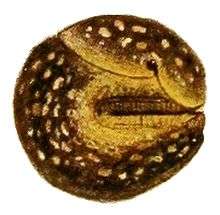
This species of slug is primarily nocturnal, in other words it is usually only active at night. During the daylight hours, these slugs are usually hidden in crevices of rocks and under loose bark on trees.[35] In Iberia, juvenile slugs of this species become active during twilight, and adults become active at night, especially on rainy or very humid nights.[8][20][35] Ireland however is much further north, so the temperatures there are considerably cooler, there is more rain, and the air is often quite damp; in Ireland this slug is sometimes active in the daytime as long as the weather is humid and overcast.[13]
The Kerry slug has a defensive behavior that is very unusual in slugs. When attacked, most land slugs will simply retract the head and contract the body, but stay firmly attached to the substrate. In contrast, when this slug is threatened, it retracts its head, lets go of the substrate, rolls up completely, and stays contracted in a ball-like shape.[8] This is a unique feature among all the Arionidae,[9] and among all slugs in Ireland.[8]
Ecology
Habitat
Geomalacus maculosus lives only in wild habitats[25] and thus it is never an agricultural pest,[25] unlike some other slugs in the family Arionidae.
In Ireland this slug inhabits wild woodland with oak trees, and oligotrophic open moorlands, as long as there are boulders covered with lichens and mosses in these habitats.[25] In Spain it usually occurs in granite mountains.[35]
The Kerry slug usually prefers acidic soil and high humidity environments, living on moss and lichen-covered rocks and trees (mainly the chestnut Castanea sativa and some species of oak), under fallen wood and under bark of rotten wood.[13] It may also occur in open areas, such as hydrophilic pastures near oligotrophic water bodies.[20]
Feeding
The food of Geomalacus maculosus includes lichens, liverworts, mosses, fungi (Fistulina hepatica)[13] and bacteria that grow on boulders and on tree trunks.[20][25][36]
In captivity, this species has been fed on porridge, bread, dandelion leaves, lichen Cladonia fimbriata and various vegetables: (carrot, cabbage, cucumber, lettuce).[8][11] It can be also carnivorous in captivity, and has been documented as devouring the snail Vitrina pellucida.[11]
Life cycle
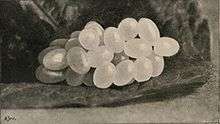
The mating of this species is in head-to-head position with genital openings facing each other.[13] Atria are shaped as a funnel with fluted edges after mating.[13] As in Arion, sperm is transferred in a spermatophore.[37] Eggs are laid in July to October in the wild,[8] and from February to October in captivity.[36] Self-fertilisation is also possible in this species.[8] The eggs are laid in clusters of 18 to 30,[8] and held together by a film of mucus. The egg masses are about 3.5 × 2 cm in overall size.[36]
The eggs are very large compared with the size of the animal, but vary within certain limits. The largest eggs are more elongate, being 8.5 × 4.25 mm; the smallest eggs are more regularly oval, and are only 6 × 3 mm. All are semitranslucent milky-white or opalescent when fresh,[38] although some of the larger and more elongate ones show a somewhat transparent area at the smaller end. The opalescent (the color changes with the light direction like an opal) lustre becomes lost in a few days, and the eggs turn yellowish, and later brown,[11] or black.[36]
The young appear to hatch in from 6[36] to 8 weeks, at which period the spots on the body of the animal are barely present. However, the lateral bands are distinct and black, much more conspicuous than they are in mature slugs of this species. In juveniles the shield shows lyre-shaped markings, as is the case in slugs of the genus Arion. However these lyre-shaped markings become indistinct as the slugs grow larger. The slugs probably pass the winter in the sexually immature stage.[11] The body of preserved juvenile specimens is up to 3 cm (1.2 in) long with a mantle length of 10 mm.[8] Juveniles reach maturity in 2 years, at a length about 2.6 cm.[8][36] The life span of Geomalacus maculosus in the wild is up to seven years,[8] but the lifespan in captivity is rarely over three years.[36] In numerous different localities in Spain, it was consistently found to be the case that no more than a very few individuals of the species were observed at any one time.[35]
There were not known natural enemies of Geomalacus maculosus up to 2014.[39] Predators of Geomalacus maculosus include larvae of the third instar of the fly Tetanocera elata.[39]
Threats to the survival of the species
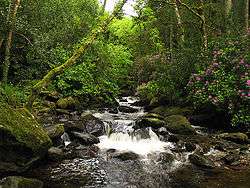
The most serious threat to the species is probably modification of the habitat, which reduces its lichen and moss food sources.[25] This can lead to the local disappearance of the species, which was documented in Spain.[25][35] Other threats include: intensification of land use (land reclamation, using of pesticides, overgrazing by sheep, removing of shrubs, building gardens, burning, and building roads and highways), tourism, general development pressure, coniferous forest plantations, the spread of invasive species of plants such as Rhododendron ponticum and habitat fragmentation[25][40] (see also Moorkens 2006).
Other potential dangers to the species include climate change and air pollution, because these negatively affect the lichens which are a food source for the slug. Climate change will probably affect the Iberian populations more seriously, because the climate there is already on the hot and dry side relative to Ireland, which is generally rather cool and damp.[25]
Conservation measures
International protection
Because of its perceived rarity and its restricted distribution, Geomalacus maculosus is protected under the Convention on the Conservation of European Wildlife and Natural Habitats (Bern Convention), EIS Bern Invertebrates Project. This decision was backed by studies of its distribution and ecology in Ireland[13] which concluded that evidence of a decline in Iberia, plus uncertainty over its status in Ireland, tended to support its inclusion in the Convention. Since 2006, Geomalacus maculosus has been considered a least concern species in the IUCN Red List,[1] however, during 1994 to 2006 the slug was rated as vulnerable.[25]
Geomalacus maculosus is also protected by the European Union's Habitats Directive (which was a response to the Bern Convention) and has been listed as an Annex II and Annex IV species since 1992.[41] There are two principal mechanisms used by the Directive to protect habitats and species:
- the creation of Special Areas of Conservation (SACs)
- the protection of species independently of their habitats by other means.
Seven SACs have been designated for this species in Ireland and 49 SCIs in Spain.[27] It is probably in areas not specifically protected as SACs that threats to the Kerry slug will be greatest. The Habitats Directive protects the Kerry slug outside the SACs by Article 12 (1), which obliges European Union member states to:
- establish ‘a system of strict protection’ for listed species
- prohibit deliberate capture or killing
- prohibit ‘deliberate disturbance … particularly during the period of breeding, rearing, hibernation and migration’
- prohibit ‘deliberate destruction or taking of eggs from the wild’
- prohibit the deliberate or non-deliberate ‘deterioration or destruction of breeding sites or resting places’.
Protection in Iberia
Conservation status reports from Portugal and from Spain were not yet available in August 2009.[42]
Its conservation status in Spain for the IUCN criteria is vulnerable.[31]
Protection in Ireland
In 1988 Platts and Speight noted that only three of the Irish sites where the slug occurred were protected: Glengariff Forest, West Cork; Uragh Wood Nature Reserve, South Kerry; and Killarney National Park, North Kerry. They concluded that the species could not be adequately safeguarded with only three sites, and therefore they supported its inclusion in the Bern list, to which the Irish government is a signatory.[13]
The Habitats Directive was transposed into Irish law by:
- The EC (Natural Habitats) Regulations 1997.[43] This was the principal legislation transposing the Habitats Directive and upgraded the protection of the Kerry slug's habitat by the designation of Special Areas of Conservation (as listed in the distribution section above).
- Adapting existing legislation. The Kerry slug has been protected since 1990 under the Irish Wildlife Act of 1976; it was added to the list of protected species by Statutory Instrument 112/1990, and was the only gastropod so protected.[41][44] The treatment of the Kerry Slug has been cited in the media as an example of hyperprotectionism (specifically, in the context of delays to a by-pass).[45] However, The Wildlife Act does not protect the slug from authorised or unauthorised indirect damage, but only from wilful direct damage such as collecting.
The Irish National Parks and Wildlife Service published a Species Action Plan for the Kerry slug in January 2008.[25][46] Efforts were made to protect the slug from indirect damage arising, for example, from commercial forestry.[47] However, following a legal challenge to Ireland's transposition and implementation of the Habitats Directive, the Action Plan was superseded in May 2010 by a Threat Response Plan. The Threat Response Plan addressed issues which arose when the European Court of Justice held that Ireland was not protecting the Kerry slug with the strictness that the directive required in respect of a species listed in annex 4.[29][48]
Monitoring
In a report to the European Commission covering 1988–2007, the conservation status of the species in Ireland was declared "favourable (FV)" in all evaluated criteria (range, population, habitat and future prospects).[8][40] However, the validity of this assessment was put into question by the European Court of Justice ruling discussed above, which held that Ireland was not monitoring the slug properly.[21]
The need to improve monitoring was discussed by the NPWS Threat Response Plan of 2010, which recognised that population statistics were still deficient, particularly outside the SACs. As the Threat Response Plan noted, species monitoring is a process in which distribution and status of the subject are evaluated systematically over time. Under this definition no monitoring of the Kerry Slug had yet been undertaken in Ireland as of May 2010.[29] In order to take matters forward, the Kerry Slug Survey of Ireland, a collaboration between the National Parks and Wildlife Service and the Applied Ecology Unit at the National University of Ireland, Galway, researched a "suitable monitoring protocol" for the species.[28][49] The Kerry Slug Survey's investigations resulted in the publication of a guide to the population dynamics of the Kerry slug; this guide was published as part of the Irish Wildlife Manual series in 2011.[50]
Captive breeding
Since 1990, the species has been successfully bred in captivity. The Wildfowl & Wetlands Trust, a British conservation organisation, operates a captive breeding programme in terraria at its "Endangered Species Breeding Unit". The project is located not within the species' normal range, but in England at the Martin Mere Wetland Centre.[36] During the 1990s, slugs from the breeding programme were given out to a number of different zoos and individuals in order to set up their own breeding programmes, but unfortunately only a very few of those breeding groups survived.[36]
References
This article incorporates public domain text from Taylor (1907).[11]
- 1 2 "Geomalacus maculosus". 2006 IUCN Red List of Threatened Species. Retrieved 18 July 2007. External link in
|work=(help) - 1 2 Allman, G. J. (1843). "On a new genus of terrestrial gasteropod". The Athenaeum. London (829): 851.
- ↑ "Geomalacus maculosus General Information". EUNIS biodiversity database. European Environment Agency (EEA). Retrieved 27 June 2010.
- 1 2 Simroth, H. (1894). "Beiträge zur Kenntniss der portugiesischen und der ostafrikanischen Nacktschnecken-Fauna". Abhandlungen der Senckenbergischen Naturforschenden Gesellschaft (in German). Frankfurt am Main. 18 (3): 289–307, table 1, figure 1, table 2, figure 1–3.
- ↑ Castro, J. da Silva (1873). "Mollusques terrestres et fluviatiles du Portugal. Espèces nouvelles ou peu connues". Jornal de sciencias mathematicas, physicas, e naturaes (in French). Lisboa. 4: 241–246.
- ↑ Simpson, D. P. (1979). Cassell's Latin Dictionary (5 ed.). London: Cassell Ltd. ISBN 0-304-52257-0.
- ↑ Wade, C. M., Mordan, P. B. & Clarke, B. (2001). "A phylogeny of the land snails (Gastropoda: Pulmonata)". Proceedings of the Royal Society B: Biological Sciences. 268 (1465): 413–422. PMC 1088622
 . PMID 11270439. doi:10.1098/rspb.2000.1372.
. PMID 11270439. doi:10.1098/rspb.2000.1372. - 1 2 3 4 5 6 7 8 9 10 11 12 13 14 15 . Conservation Status Assessment Report. National Parks & Wildlife Service, Department of the Environment, Heritage and Local Government, Ireland. February 2008. Missing or empty
|title=(help);|contribution=ignored (help) 9 pp. - 1 2 Kerney, M. P; Cameron, A. D.; Jungbluth, J. H. (1983). Die Landschnecken Nord- und Mitteleuropas (in German). Hamburg and Berlin: Verlag Paul Parey. p. 138. ISBN 3-490-17918-8.
- 1 2 O'Hanlon, A; Feeney, K (2017-07-10). "Quantifying phenotype-environment matching in the protected Kerry spotted slug (Mollusca: Gastropoda) using digital photography: exposure to UV radiation determines cryptic colour morphs". Frontiers in Zoology. Retrieved 2017-07-16.
- 1 2 3 4 5 6 7 8 9 10 11 12 13 14 15 16 17 18 19 20 21 22 23 24 Taylor, J. W. (1907). Monograph of the land and freshwater Mollusca of the British Isles. Testacellidae. Limacidae. Arionidae. pt 8–14. Leeds: Taylor brothers. pp. 253–259.
- 1 2 Scharff, R. F. (1891). The slugs of Ireland. The Scientific Transactions of the Royal Dublin Society, volume IV., series II. Dublin, Royal Dublin Society; London, Williams & Norgate. 513–563. Cited pages: 551–556.
- 1 2 3 4 5 6 7 8 9 10 11 12 13 14 Platts, E. A.; Speight, M. C. D. (1988). "The taxonomy and distribution of the Kerry slug Geomalacus maculosus Allman, 1843 (Mollusca: Arionidae) with a discussion of its status as a threatened species". Irish Naturalists' Journal. 22 (10): 417–430.
- 1 2 Pilsbry H. A. (1898). "Phylogeny of the genera of Arionidae". Proceedings of the Malacological Society of London 3: 94-104.
- 1 2 3 Godwin-Austen, H. H. (1882). Land and freshwater mollusca of India, including South Arabia, Baluchistan, Afghanistan, Kashmir, Nepal, Burma, Pegu, Tenasserim, Malaya Peninsula, Ceylon and other islands of the Indian Ocean; Supplementary to Masers Theobald and Hanley's Conchologica Indica. Plates to Volume I. Taylor and Francis, London. Plate XII, figure 5.
- ↑ (in German) Simroth, H. (1891). "Die nacktschnecken der portugiesisch-azorischen fauna in ihrem Verhältnis zu denen der paläarktischen region überhaupt". Nova Acta Academiae Caesareae Leopoldino-Carolinae Germanicae Naturae Curiosorum 56(1): 201–424, Tab. IX-XVIII. Halle. Geomalacus maculosus is on page 351–355.
- ↑ (in French) Germain L. (1930). Mollusques terrestres et fluviatiles. Première partie. Faune Fr., lechevalier, Paris, 21: 477 pp.
- ↑ Quick H. E. (1960). "British slugs (Pulmonata; Testacellidae, Arionidae, Limacidae". Bulletin of the British Museum (Natural History). Zoology 6(3): 103-226.
- ↑ "Family summary for Arionidae". AnimalBase, last change 12-06-2009, accessed 4 August 2010.
- 1 2 3 4 5 6 "Plano Sectorial da Rede Natura 2000. "Fauna, Invertebrados"" (PDF) (in Portuguese). Portugal: Instituto de Conservação da Natureza e da Biodiversidade. 2006. Archived from the original (PDF) on 26 December 2009. Retrieved 25 September 2009.
- 1 2 Viney, Michael (May 5, 2010). "Problems with plan for protection of slugs". Irish Times. Retrieved May 2, 2012.
- ↑ Mascheretti, S.; Rogatcheva, M.B.; Gündüz, İ.; Fredga, K.; Searle, J.B. (2003). "How did pygmy shrews colonize Ireland? Clues from a phylogenetic analysis of mitochondrial cytochrome b sequences". Proceedings of the Royal Society B. 270: 1593–1599. PMC 1691416
 . PMID 12908980. doi:10.1098/rspb.2003.2406.
. PMID 12908980. doi:10.1098/rspb.2003.2406. - ↑ Reich, I.; Gormally, M.; Allcock, A.L.; Mc Donnell, R.; Castillejo, J.; Iglesias, J.; Quinteiro, J; Smith, C.J. (2015). "Genetic study reveals close link between Irish and Northern Spanish specimens of the protected Lusitanian slug Geomalacus maculosus". Biological Journal of the Linnean Society. 116: 156–168. doi:10.1111/bij.12568.
- ↑ Genetic study reveals close link between Irish and Northern Spanish specimens of the protected Lusitanian slug Geomalacus maculosus. 2015 The Linnean Society of London, Biological Journal of the Linnean Society
- 1 2 3 4 5 6 7 8 9 10 11 12 13 Species Action Plan. Kerry Slug. Geomalacus maculosus (PDF). Ireland: National Parks & Wildlife Service, Department of the Environment, Heritage and Local Government, Ireland. January 2008. Archived from the original (PDF) on 2007-12-18. 9 pp.
- ↑ Kearney, Jon (2010). "Kerry slug (Geomalacus maculosus Allman 1843) recorded at Lettercraffroe, Co. Galway.". Irish Naturalists Journal. 31: 68–69.
- 1 2 3 Geomalacus maculosus. EUNIS (European Nature Information System), European Topic Centre on Biological Diversity, European Environment Agency. Retrieved 2017-06-17.
- 1 2 Ketch, Catherine (2012), Kerry Slug researcher visits Baile Bhúirne and Beara, The Corkman
- 1 2 3 Threat Response Plan, Ireland: National Parks & Wildlife Service. Retrieved 24 June 2012
- ↑ Castillejo, J. (1998). Guia de las babosas Ibericas (in Spanish). Santiago de Compostela: Real Academia de Ciencias. 154 pp.
- 1 2 3 4 Castillejo, J.; Iglesias, J. (2007). Geomalacus (Geomalacus) maculosus Allman, 1843. Libro Rojo de los Invertebrados de España (PDF) (in Spanish). pp. 351–352.
- ↑ Sierra de los Ancares, Urugallo cantábrico website (LIFE Programme: Capercaillie Project)
- ↑ "Ancares (ES0000374)". EEA. Retrieved 21 July 2016.
- ↑ "Ancares-Courel (ES1120001)". EEA. Retrieved 22 July 2016.
- 1 2 3 4 5 Ramos, M. A. (1998). "Implementing the habitats directive for mollusc species in Spain". Journal of Conchology. Molluscan Conservation: A Strategy for the 21st Century, Special Publication (2): 125–132.
- 1 2 3 4 5 6 7 8 9 Wiesniewski, P. J. (2000). "Husbandry and breeding of Kerry spotted slug". International Zoo Yearbook. 37 (1): 319–321. doi:10.1111/j.1748-1090.2000.tb00736.x. (subscription required)
- ↑ Rodriguez,, T.; Ondina, P.; Outeiro, A.; Castillejo, J. (1993). "Slugs of Portugal. III. Revision of the genus Geomalacus Allman, 1843 (Gastropoda:Pulmonata: Arionidae)" (PDF). Veliger. 36 (2): 145–159. Retrieved 7 March 2016.
- ↑ Rogers, T. (1900). "The eggs of the Kerry Slug Geomalacus maculosus, Allman". Irish Naturalist. 9: 168–170, plate 5.
- 1 2 Giordani I.; Hynes T.; Reich I.; Mc Donnell R. J.; Gormally M. J. (2014). "Tetanocera elata (Diptera: Sciomyzidae) Larvae Feed on Protected Slug Species Geomalacus maculosus (Gastropoda: Arionidae): First Record of Predation". Journal of Insect Behavior. 27 (5): 652–656. doi:10.1007/s10905-014-9457-1.
- 1 2 . Conservation Status Assessment Report. National Parks & Wildlife Service, Department of the Environment, Heritage and Local Government, Ireland. 25 February 2008. Missing or empty
|title=(help);|contribution=ignored (help) - 1 2 "Checklist of protected & rare species in Ireland" (PDF). National Parks & Wildlife Service, Department of the Environment, Heritage and Local Government, Ireland. 7 January 2009. 15 pp., cited page: p. 12.
- ↑ Eionet (European Environment Information and Observation Network), European Topic Centre on Biological Diversity. "Geomalacus maculosus". Retrieved 18 August 2009.
- ↑ SI 94/1997 as amended by EC (Natural Habitats) (Amendment) Regulations SI 233/1998 and SI 378/2005.
- ↑ "Wildlife Act, 1976 (Protection of Wild Animals) Regulations, 1990". Retrieved August 30, 2012.
- ↑ "By the Time We've Saved the Slugs, the Snails and Those Viking Graves, Who Will Save the Commuter?". Daily Mail (London). McClatchy-Tribune Information Services. 2007. Retrieved July 21, 2014 from HighBeam Research (subscription required)
- ↑ Bruce, Helen (January 2008). "On the wild frontier; (1) Under threat: The otter is a perennial favourite for children and nature enthusiasts, with its expressive features, dog-like playfulness, grace in the water and furry coat (2) Image problem: Not as cuddly as the otter but the Kerry Slug is still in need of our help.". Daily Mail (London). McClatchy-Tribune Information Services. HighBeam Research (subscription required). Retrieved August 30, 2012.
- ↑ "Kerry Slug and Otter Guidelines". The Forest Service, Department of Agriculture, Fisheries and Food. 2009. Retrieved October 9, 2012.
- ↑ Commission v Ireland C-183/05. (The court case did not just involve the Kerry slug, but considered wider transposition failures by Ireland).
- ↑ Kerry Slug Survey of Ireland (Official Website) Retrieved 3 July 2010.
- ↑ Mc Donnell, R.J. and Gormley M.J. (2011). Distribution and population dynamics of the Kerry Slug, Irish Wildlife Manual No 54, National Parks and Wildlife Service, Department of Arts, Heritage and the Gaeltacht, Dublin
Further reading
- Allman, G. J. (1844). "On a new genus of terrestrial gastropod". Report of the British Association for the Advancement of Science 1843: 77.
- Allman, G. J. (1846). "Description of a new genus of pulmonary gastropods". Annals and Magazine of Natural History 17: 297–299, plate 9.
- Boycott A. E., Oldham C. (1930). "The food of Geomalacus maculosus". Journal of Conchology. 19: 36.
- Oldham, C. (1942). "Notes on Geomaculus maculosus". Proceedings of The Malacological Society of London 25.
- Heynemann, D. F. (1873). "On the French species of the genus Geomalacus". Annals and Magazine of Natural History, pages 271–275.
- (in German) Heynemann, D. F. (1869). "Zur Kenntniss von Geomalacus". Nachrichtsblatt der Deutschen Malakozoologischen Gesellschaft, pages 165–168.
- (in German) Heynemann, D. F. (1871). "Geomalacus maculosus". Nachrichtsblatt der Deutschen Malakozoologischen Gesellschaft 3(1): 126.
- (in German) Heynemann, D. F. (1873). "Ueber Geomalacus". Malakozoologische Blätter xxi: 25–36, table 1, fig. 1-6.
- Moorkens, E. A. (2006). "Irish non-marine molluscs – an evaluation of species threat status". Bulletin of the Irish Biogeographical Society 30: 348–371. OCLC 265510707.
- Scharff, R. F. (1892). "Land and freshwater shells peculiar to the British Isles". Nature, 46(1178): 173. doi:10.1038/046173d0
- Scharff, R. F. (1893). "Note on the geographical distribution of Geomalacus maculosus Allman, in Ireland". Proceedings of the Malacological Society of London, volume I, 1893–1895, 17–18.
External links
| Wikimedia Commons has media related to Geomalacus maculosus. |
- Geomalacus maculosus at Animalbase taxonomy,short description, distribution, biology,status (threats), images
- Bridges & Species: Post-Glacial Colonisation
- A photograph of a live individual
- Mollusc Ireland

